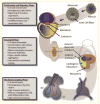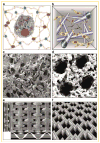Geometry and force control of cell function
- PMID: 19795385
- PMCID: PMC2803742
- DOI: 10.1002/jcb.22355
Geometry and force control of cell function
Abstract
Tissue engineering is becoming increasingly ambitious in its efforts to create functional human tissues, and to provide stem cell scientists with culture systems of high biological fidelity. Novel engineering designs are being guided by biological principles, in an attempt to recapitulate more faithfully the complexities of native cellular milieu. Three-dimensional (3D) scaffolds are being designed to mimic native-like cell environments and thereby elicit native-like cell responses. Also, the traditional focus on molecular regulatory factors is shifting towards the combined application of molecular and physical factors. Finally, methods are becoming available for the coordinated presentation of molecular and physical factors in the form of controllable spatial and temporal gradients. Taken together, these recent developments enable the interrogation of cellular behavior within dynamic culture settings designed to mimic some aspects of native tissue development, disease, or regeneration. We discuss here these advanced cell culture environments, with emphasis on the derivation of design principles from the development (the biomimetic paradigm) and the geometry-force control of cell function (the biophysical regulation paradigm).
Figures




Similar articles
-
Engineered microenvironments for controlled stem cell differentiation.Tissue Eng Part A. 2009 Feb;15(2):205-19. doi: 10.1089/ten.tea.2008.0131. Tissue Eng Part A. 2009. PMID: 18694293 Free PMC article. Review.
-
Biomimetic approach to tissue engineering.Semin Cell Dev Biol. 2009 Aug;20(6):665-73. doi: 10.1016/j.semcdb.2008.12.008. Epub 2008 Dec 25. Semin Cell Dev Biol. 2009. PMID: 19146967 Free PMC article. Review.
-
Engineered microenvironments provide new insights into ovarian and prostate cancer progression and drug responses.Adv Drug Deliv Rev. 2014 Dec 15;79-80:193-213. doi: 10.1016/j.addr.2014.06.001. Epub 2014 Jun 23. Adv Drug Deliv Rev. 2014. PMID: 24969478 Review.
-
Biomimetic platforms for human stem cell research.Cell Stem Cell. 2011 Mar 4;8(3):252-61. doi: 10.1016/j.stem.2011.02.014. Cell Stem Cell. 2011. PMID: 21362565 Free PMC article.
-
Spheroid-Hydrogel-Integrated Biomimetic System: A New Frontier in Advanced Three-Dimensional Cell Culture Technology.Cells Tissues Organs. 2025;214(2):128-147. doi: 10.1159/000541416. Epub 2024 Sep 12. Cells Tissues Organs. 2025. PMID: 39265553 Free PMC article. Review.
Cited by
-
Osteoimmunomodulatory Nanoparticles for Bone Regeneration.Nanomaterials (Basel). 2023 Feb 10;13(4):692. doi: 10.3390/nano13040692. Nanomaterials (Basel). 2023. PMID: 36839060 Free PMC article. Review.
-
Controlled two-photon photodegradation of PEG hydrogels to study and manipulate subcellular interactions on soft materials.Soft Matter. 2010;6(20):5100-5108. doi: 10.1039/C0SM00174K. Soft Matter. 2010. PMID: 21984881 Free PMC article.
-
Comparison of Cytomorphometry and Early Cell Response of Human Gingival Fibroblast (HGFs) between Zirconium and New Zirconia-Reinforced Lithium Silicate Ceramics (ZLS).Int J Mol Sci. 2018 Sep 11;19(9):2718. doi: 10.3390/ijms19092718. Int J Mol Sci. 2018. PMID: 30208663 Free PMC article.
-
Astrocytes increase ATP exocytosis mediated calcium signaling in response to microgroove structures.Sci Rep. 2015 Jan 19;5:7847. doi: 10.1038/srep07847. Sci Rep. 2015. PMID: 25597401 Free PMC article.
-
Current Development of Nano-Drug Delivery to Target Macrophages.Biomedicines. 2022 May 23;10(5):1203. doi: 10.3390/biomedicines10051203. Biomedicines. 2022. PMID: 35625939 Free PMC article. Review.
References
-
- Abu-Issa R, Kirby ML. Heart field: From mesoderm to heart tube. Annu Rev Cell Dev Biol. 2007;23:45–68. - PubMed
-
- Altman GH, Horan RL, Martin I, Farhadi J, Stark PR, Volloch V, Richmond JC, Vunjak-Novakovic G, Kaplan DL. Cell differentiation by mechanical stress. FASEB J. 2002;16:270–272. - PubMed
-
- Belousov LV, Ermakov AS. Artificially applied tensions normalize development of relaxed Xenopus Laevis embryos. Ontogenez. 2001;32:288–294. - PubMed
-
- Benya PD, Shaffer JD. Dedifferentiated chondrocytes reexpress the differentiated collagen phenotype when cultured in agarose gels. Cell. 1982;30:215–224. - PubMed
Publication types
MeSH terms
Grants and funding
LinkOut - more resources
Full Text Sources
Other Literature Sources

